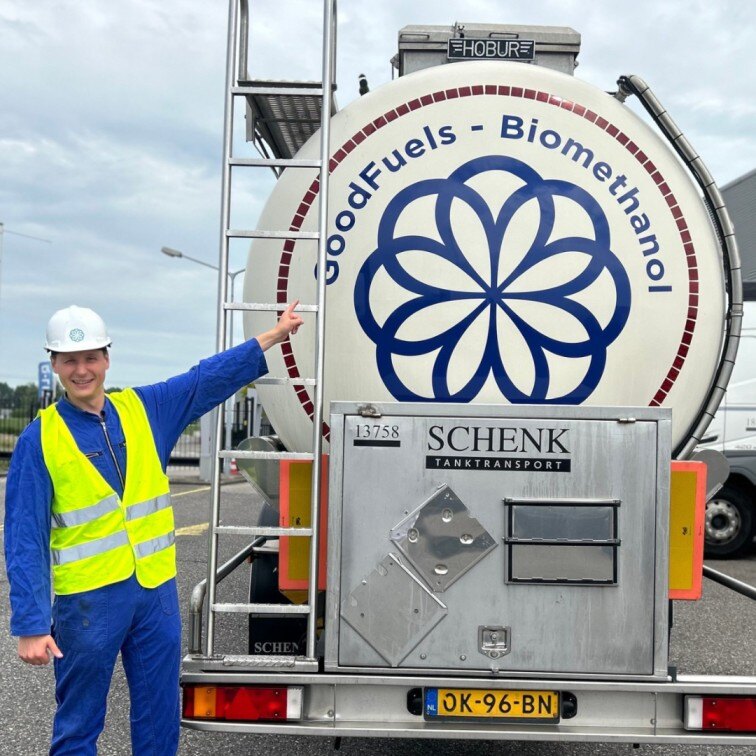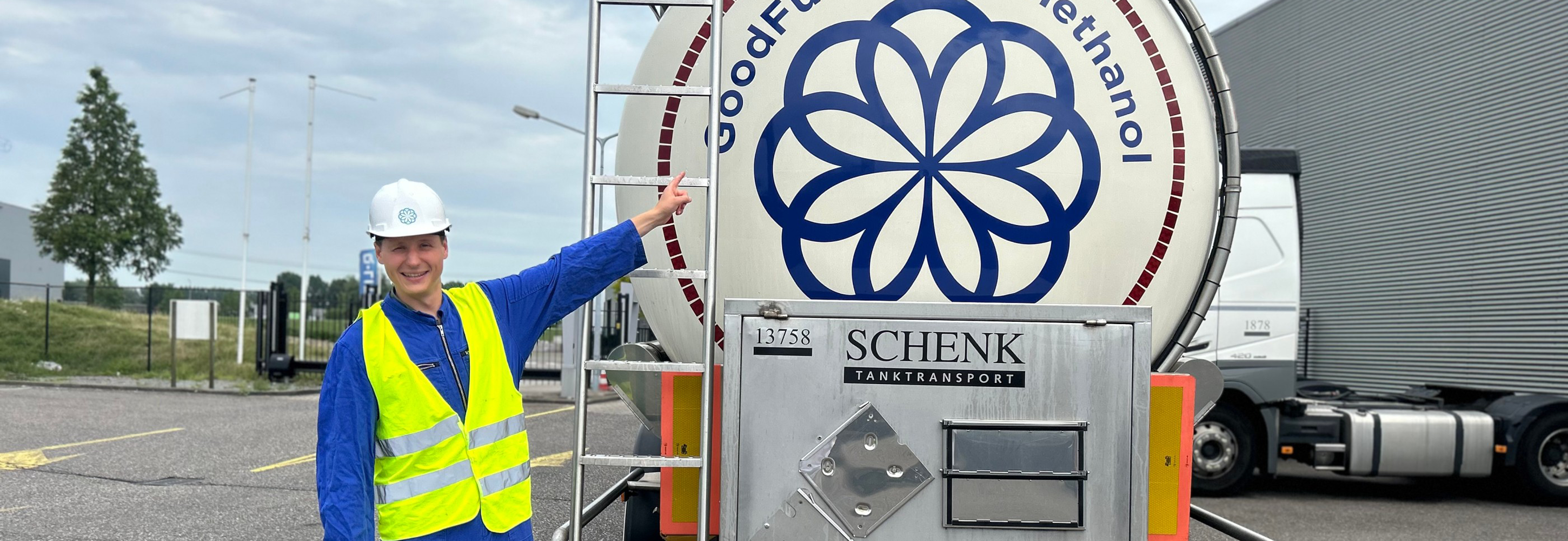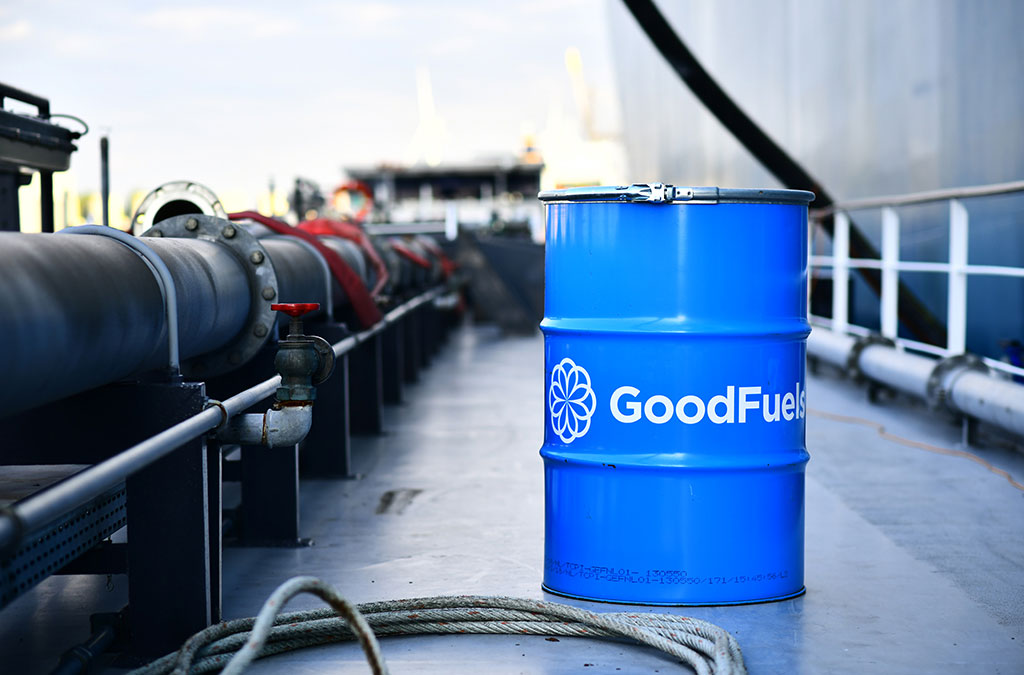

In the maritime sector's quest for alternative fuels, biomethanol is currently considered a promising mid-to-long term alternative shipping fuel. In fact, it ticks a lot of boxes for vessel owners and operators – it significantly cuts NOx, SOx, and particulate emissions, and is easier to store and handle onboard compared to other alternative fuels like hydrogen or ammonia.
In this article, we will explore the ins and outs of different green methanol types, examining what makes this fuel different from other alternatives, its potential applications, and whether it could be the solution the marine industry is looking for. We will conclude by outlining the operational setup of GoodFuels biomethanol deliveries.
“We strongly believe that biomethanol will play a leading role in the future for global shipping. Although the market has yet to mature, meaning uniform quality standards, production facilities and end users are yet to be developed, we have prepared ourselves for customers that want to be ahead of the curve — just like us. This means we are actively building up knowledge about the logistics and use of biomethanol. With this knowledge, we have set up a biomethanol supply chain with which we are one of the first parties to supply biomethanol to the maritime sector.” -
Hidde Schijen, Biomethanol Project Lead.
What is biomethanol?
Biomethanol is a renewable form of methanol produced from sustainable feedstock, such as waste streams of biogenic origin - manure, agricultural and food waste.
What sets biomethanol apart is that it’s derived from biogenic sources, meaning it comes from living or recently living organisms. In contrast, green methanol, for example, can also be produced by combining captured carbon dioxide with renewable hydrogen.

What is methanol?
Methanol, a basic alcohol, has long been used in the chemical sector as a feedstock for thousands of everyday products, including plastics, paints and cosmetics. Recently though, it is being increasingly more recognised as an alternative fuel in the marine sector.
Methanol is relatively safe to handle, being a clear and colorless liquid at room temperature. This ease of handling, compared to other alternative fuels like ammonia or hydrogen, combined with its ability to be produced from a wide range of feedstocks, including renewable sources, positions methanol as a flexible and sustainable fuel option.
Additionally, methanol's biodegradability reduces the environmental impact of potential spills, as it breaks down more quickly than traditional marine fuels.
What types of methanol exist?
Based on their environmental impact and the sustainability of their production processes, green methanol and grey methanol represent two core categories within the broader methanol market.
Grey methanol
Grey methanol, also known as fossil methanol, is a type of methanol produced from natural gas or coal and has traditionally been used in the chemical industry due to its established, relatively cost-efficient production process and infrastructure.
However, the impact of GHG emissions generated by grey methanol is significant, compared to the green alternative. Grey methanol even has higher well-to-wake emissions (estimated at 12% higher on full lifecycle) than VLSFO (Very Low Sulfur Fuel Oil). The production process involves reforming natural gas to create synthesis gas (a mixture of hydrogen and carbon monoxide), which is catalytically converted into methanol.
Below you can find a simplified representation of what such a process looks like.

Figure 1. Grey methanol production process
Green methanol
Green methanol is derived from renewable sources such as biomass, municipal waste, and captured carbon dioxide. It offers a sustainable, versatile fuel alternative that can significantly reduce greenhouse gas emissions and dependency on fossil fuels. Green methanol can reduce CO2 emissions by up to 95%, nitrogen oxide emissions by up to 80%, and can eliminate sulfur oxide and particulate matter emissions.
The renewable methanol market is set for substantial growth, with the Methanol Institute tracking 170 projects globally, projecting a total capacity of 20.87 million tons by 2027 and 26.72 million tons (33.82 billion liters) by 2029. The capacity of e-methanol and biomethanol projects is anticipated to reach 16.43 million tons and 10.29 million tons, respectively, by 2029, highlighting the rapid expansion and increasing significance of renewable methanol in the energy landscape.
Renewable methanol could greatly benefit the logistics industry by serving as a sustainable alternative to fossil fuels. The core applications of green methanol include:
- Transport fuel: With land transport being a major pollution source, blending renewable methanol into gasoline could significantly cut CO2 emissions in logistics, a practice already common in the UK.
- Shipping fuel: Green methanol can meet the high demand for marine fuels, leveraging existing methanol infrastructure at seaports for a seamless transition.
- Power generation: As a clean fuel, renewable methanol can replace diesel, and petrol in electricity generation, reducing industrial emissions.
Green methanol has several subtypes based on its feedstock and production processes. The primary subtypes include (in order of technological and commercial readiness): mass balanced methanol, waste-based biomethanol, and e-methanol.
Mass-balanced methanol
This type of methanol is produced using the mass balance approach, which involves the combination of renewable and fossil-based feedstocks in a single production system. Biogas, produced from the anaerobic digestion of organic waste, is pumped into the natural gas grid. In this grid both types of gas (bio and natural) are mixed. A methanol production plant undergoes the standard methanol production process, which includes converting the gas from the grid into synthesis gas (syngas) and then into methanol using a catalytic process.
To state that the methanol is green, “biogas-tickets” are bought which correspond to the amount of gas needed to produce the methanol. As a result, the final methanol product is certified as mass balanced. This certification process facilitates a gradual transition towards sustainable production practices without requiring separate production infrastructure. Traceability may be less precise with this production method, as the resulting product is not truly biogenic.

Figure 2. Mass-balanced methanol production process
Waste-based biomethanol
Waste-based biomethanol is produced from various forms of waste, including forestry and agricultural byproducts, municipal solid waste (MSW), sewage, and industrial waste.
The technological and commercial readiness of this biomethanol is medium to high. Several demonstration and pilot plants are operational, and commercial-scale plants are emerging.
One method of producing waste-based biomethanol is recovery, where waste streams from industries are cleaned to isolate methanol for further applications.

Figure 3. Waste-based methanol recovery production process
Another method is gasification, which converts solid waste into syngas at elevated temperatures using oxidising agents.
Gasification involves production of a gas from a solid fuel at elevated temperatures using oxidising agents such as air, oxygen, steam, carbon dioxide, etc. The temperature generally ranges from 600° to 1000°C. The necessary heat for the reactions is supplied either by burning a portion of the feedstock with pure oxygen or through an indirect external heat source. The syngas produced from the gasifier must be cleaned and conditioned to meet the specifications required for the downstream methanol synthesis process.
By converting waste materials into biomethanol, this process significantly reduces the volume of waste that would otherwise end up in landfills or be incinerated. This helps in reducing landfill use and associated methane emissions.

Figure 4. Waste-based methanol gasification production process
Excuse me, “e-methanol”?!
E-methanol is a more sustainable form of methanol produced by capturing carbon dioxide (CO2) from industrial processes or directly from the air and combining it with hydrogen generated from renewable electricity sources such as wind or solar power. With a high potential GHG reduction profile e-methanol stands out as an exceptionally future green fuel alternative.
E-methanol is at a stage where its technological readiness is high, and commercial deployment is progressing from pilot to larger-scale projects. Market adoption is growing, driven by environmental regulations and corporate sustainability goals, but cost and scalability remain significant challenges.
The production process of e-methanol not only utilises excess CO2, but also leverages renewable energy to produce hydrogen through water electrolysis. The resulting e-methanol serves as a carbon-neutral fuel and chemical feedstock, offering a promising solution to reduce carbon emissions and dependence on fossil fuels.

Figure 5. E-methanol production process
Pioneering biomethanol: GoodFuels’ commitment to a greener future
We strongly believe in biomethanol's potential to shape the future of sustainable shipping. This is why investments have been made to diligently build an entire supply chain so this innovative product can be delivered swiftly and effectively.
Also, as one of the first available in the market, GoodFuels biomethanol is 100% biogenic. This means that the supplied biomethanol is fully based on organic material and is as sustainable as can be found in the market today.
Moreover, GoodFuels biomethanol achieves an ISCC certified CO2 reduction of a staggering 92.4%. That said, as a shipowner there is a variety of options available to suit your specific needs. Just like with sustainable biofuels for shipping, you can customise the blend to match your preferred level of GHG reduction.
Biomethanol now available for delivery in ARA
Following last year’s initiative to supply GoodFuels biomethanol in the Port of Amsterdam, this revolutionary new fuel type is now available for delivery throughout the ARA region. This initiative marks a significant step forward in expanding access to sustainable fuel options in maritime shipping.
-1.jpg?width=1344&height=756&name=Read%20more%20(4)-1.jpg)
In an industry first, FincoEnergies received a waiver from the Port of Amsterdam last year, allowing the transport of biomethanol by truck. Additionally, biomethanol can be delivered by barge in collaboration with our trusted partners.
Given the specific requirements for handling low flashpoint fuels, shipping companies are encouraged to select their preferred bunker locations well in advance to ensure the necessary permits are obtained without delay.
Start trialing biomethanol today
Owners and operators of methanol-ready barges that are eager to start reducing their footprint with this promising fuel can request a biomethanol trial here.
For more information or inquiries about GoodFuels biomethanol, please contact Cas Snijders (commercial requests) and Hidde Schijen (biomethanol project lead).
Try out biomethanol today
REQUEST YOUR TRIAL
Ready to join us on our mission to accelerate the transitions to fossil-free transport? When you request your first trial, we will provide you with a tailor-made solution that fits your needs and goals. No worries: we'll take you through the process and show you how everything works.






